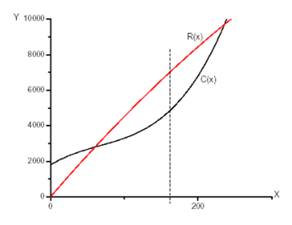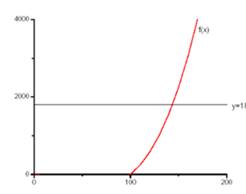
(a)
To find: The production level for maximum profit by the graphs.
(a)
Answer to Problem 48RE
The production level of
Explanation of Solution
Given information:
The given information is
Commodity is
Demand function is
Calculation:
The cost function is
Demand function is
The revenue function
Or
Now we draw the curve of
That is at the production level of

Therefore, the production level of
(b)
To find: The production level for maximum profit by calculus method.
(b)
Answer to Problem 48RE
The production level
Explanation of Solution
Given information:
The given information is
Commodity is
Demand function is
Calculation:
Now the marginal revenue function is
And marginal cost function is
For maximize the profit we must have
Or
The root of the equation
Here we are not considering
Thus we have
Since
So
Therefore, the production level
(c)
To find: The production level that minimizes the average cost.
(c)
Answer to Problem 48RE
The production level of
Explanation of Solution
Given information:
The given information is
Commodity is
Demand function is
Calculation:
Now the average cost function is
And marginal cost is
For minimum average cost we must have
By graphical method
We draw the curve

We estimate the point of intersection of these curves. The x-coordinate of the point of intersection is about
So at the production level of
Now,
Then
And
So at
Chapter 4 Solutions
Single Variable Calculus: Concepts and Contexts, Enhanced Edition
 Calculus: Early TranscendentalsCalculusISBN:9781285741550Author:James StewartPublisher:Cengage Learning
Calculus: Early TranscendentalsCalculusISBN:9781285741550Author:James StewartPublisher:Cengage Learning Thomas' Calculus (14th Edition)CalculusISBN:9780134438986Author:Joel R. Hass, Christopher E. Heil, Maurice D. WeirPublisher:PEARSON
Thomas' Calculus (14th Edition)CalculusISBN:9780134438986Author:Joel R. Hass, Christopher E. Heil, Maurice D. WeirPublisher:PEARSON Calculus: Early Transcendentals (3rd Edition)CalculusISBN:9780134763644Author:William L. Briggs, Lyle Cochran, Bernard Gillett, Eric SchulzPublisher:PEARSON
Calculus: Early Transcendentals (3rd Edition)CalculusISBN:9780134763644Author:William L. Briggs, Lyle Cochran, Bernard Gillett, Eric SchulzPublisher:PEARSON Calculus: Early TranscendentalsCalculusISBN:9781319050740Author:Jon Rogawski, Colin Adams, Robert FranzosaPublisher:W. H. Freeman
Calculus: Early TranscendentalsCalculusISBN:9781319050740Author:Jon Rogawski, Colin Adams, Robert FranzosaPublisher:W. H. Freeman
 Calculus: Early Transcendental FunctionsCalculusISBN:9781337552516Author:Ron Larson, Bruce H. EdwardsPublisher:Cengage Learning
Calculus: Early Transcendental FunctionsCalculusISBN:9781337552516Author:Ron Larson, Bruce H. EdwardsPublisher:Cengage Learning





